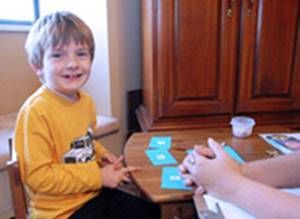"ABA" Treatment
Applied Behaviour Analysis

Christopher and Allie Learning Letters, 2008
Applied Behaviour Analysis (ABA) is widely accepted to be the most effective evidence-based therapeutic approach developed to date for children with Autism. The structured teaching of functional skills (often called behavioural intervention) presently has the largest body of published research supporting its effectiveness. ABA has been evolving and improving for decades. It is the gold standard of autism treatment.
ABA is the process of systematically applying the interventions based upon the principles of learning theory to improve socially significant behaviours to a meaningful degree, and to demonstrate that the interventions employed are responsible for the improvement in behaviour.
"Socially significant behaviours" include reading, academics, social skills, communication, and adaptive living skills. Adaptive living skills include gross and fine motor skills, eating and food preparation, toiling, dressing, personal self-case, domestic skills, time and punctuality, money and value, home and community orientation, and work skills.
ABA methods are used to support persons with Autism in at least six ways:
1. To increase desirable behaviours (Ex: reinforcement procedures increase on-task behaviour, or social interactions)
2. To teach new skills (Ex: systematic instruction and reinforcement procedures teach functional life skills, communication skills, or social skills)
3. To maintain behaviours (Ex: teaching self control and self-monitoring procures to maintain and generalize job-related social skills)
4. To generalize or to transfer behaviour from one situation or responds to another (Ex: from completing assignments in the resource room to performing as well in the mainstream classroom)
5. To restrict or narrow conditions under which interfering behaviours occur (Ex: modifying the learning environment)
6. To reduce interfering behaviours (Ex: self injury or stereotype)
Resource: Information provided by the Autism Support Network Society.
